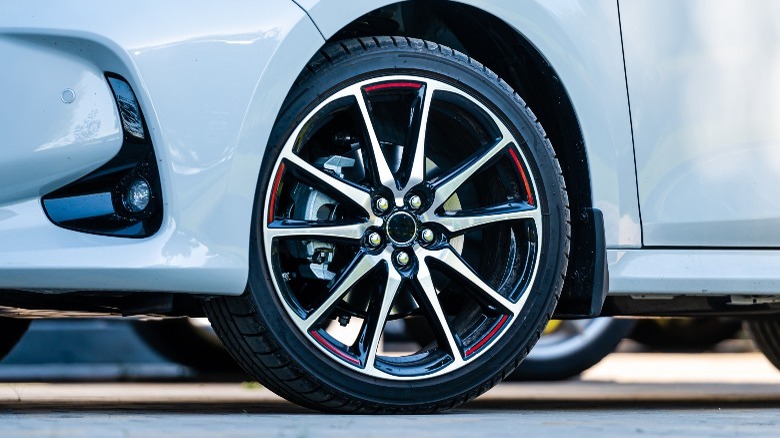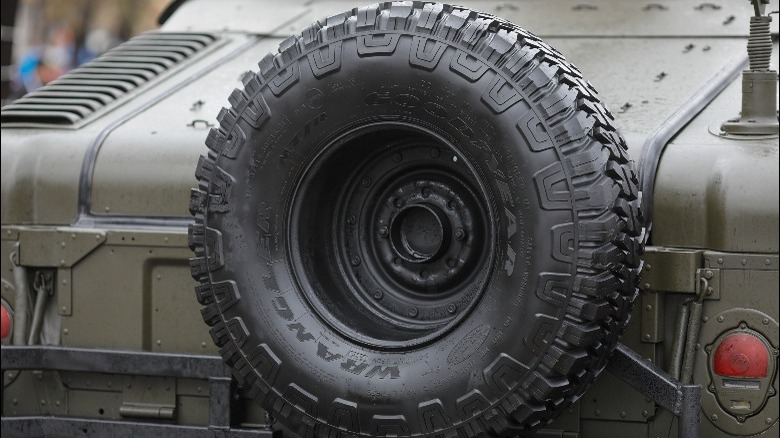Low Profile Vs. Standard Tires: What's The Difference?
Every few years, car owners need to think about getting new tires. Maybe you're seeing signs that the tires need to be replaced: uneven tread wear, minimal tread left, unsightly bulges. Maybe you just want a new look.
One of the many decisions you could make in shopping for the next set is whether to go with low-profile tires or regular tires. Many people buy low-profile tires for a sportier look, but switching to these from regular tires involves extra consideration. For one thing, they cost more and are more expensive to replace than regular tires. Also, low-profile tires fit bigger wheels than regular tires for the same vehicle, so switching tires may include the extra expense of switching wheels to make sure the overall tire diameter stays within manufacturer specs. The wrong size wheel and tire might not fit in the wheel well, and could affect the accuracy of the vehicle's speedometer and even gearing.
But, once you have the right size tires for your vehicle, is there any real difference in performance whether they are low profile or regular?
What are low-profile tires?
These are tires with an aspect ratio between 30 and 40, typically. The aspect ratio is a number that represents sidewall height as a percentage of tire width and can be found in the string of numbers stamped on the side of each tire. A low-profile tire would have numbers such as 305/30R19 on its sidewall, where 305 is the tire width in millimeters and 30 is the aspect ratio, meaning the sidewall height is a little less than one-third of the width of the tire. The last number, 19, is the diameter of the wheel it's designed for, in inches. Though these tires look skinnier from the side, they tend to be wider across the treads than regular tires.
The advantages of low-profile tires are that their shorter sidewalls flex less than regular tires, for less sway through corners and better skidpad performance. The wider wheels create a bigger contact patch for better grip during turning and stopping.
These tires' downsides come, in part, from their added weight which negatively affects fuel efficiency and acceleration. Wider wheels produce more air turbulence than narrower tires, reducing fuel efficiency in gas cars and range in electric cars. The shorter sidewall gives a harsher ride, and can more easily get a pinch flat on curbs or potholes, not to mention potential rim damage from the rim being closer to impact surfaces than on a regular tire.
What are high-profile tires?
High-profile wheels have a higher aspect ratio of 50 or more. Another definition of high-profile is having a tread thickness greater than ¾ inches. These tires' sidewalls and treads are so tall that they are often designed for smaller wheels, from 10' to 16" in diameter.
Since these tires are designed for off-roading, the chunky treads help increase the vehicles' ground clearance, protect the tires from failing due to pothole and obstacle damage, smooth out the ride a little, and improve traction on uneven or deep surfaces. But cornering is not their strong suit. The tall sidewalls and treads will flex– sometimes too much to maintain good grip. The steering response can be dampened from this flexing, too, leading drivers to feel some lag on turning the steering wheel. Also, vehicles with smaller engines might suffer from reduced torque trying to spin up those fatter tires.
Which one's right for you?
When considering the best wheels and tires for your vehicle's manufacturer specs, the choice between low-profile and regular tires depends on factors such as how much money you have to spend on tires and replacements, how many miles you want the tires to last, the terrain you plan to drive over, and the weather conditions.
Low-profile tires can improve a car's handling and look fantastic doing it on smooth surfaces. For twisty mountain roads and Friday night cruising they are hard to beat. But less rubber depth means a bumpier ride in city streets with lots of potholes. Vehicles that weren't designed with low-profile tires in mind might suffer more wear and tear to their suspension, doing more harm than good to the car.
Low-profiles aren't ideal for off-pavement driving, as the proximity of the wheel to the ground allows gravel or sand to work into the bead of the tire, causing damage. The stiff sidewall lessens traction over larger bumps and debris, while the wider footprint of the tread can even lead to hydroplaning in wet weather driving.
Standard tires on smaller wheels improve gas mileage and acceleration, so drivers concerned about cost or facing stop and go traffic will find these lower cost tires a better deal all around. They save money by lasting longer than performance low profiles, too. For day-to-day commuting and long road trips, they offer a smoother ride as their sidewalls absorb bumps better by flexing more.



